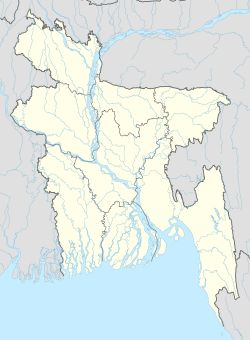world.wikisort.org - Bangladesh
Naogaon (Bengali: নওগাঁ Nôogã) is a city and district headquarter of Naogaon District in northern Bangladesh. It is located in the bank of Mini Jamuna river. It is the centre of commerce within the Naogaon District. The area of the town is about 38.36 km2 (14.81 sq mi) and the population is about 150,025. The municipality consists of 9 wards and 56 mahallas.
This article has multiple issues. Please help improve it or discuss these issues on the talk page. (Learn how and when to remove these template messages)
|
Naogaon
নওগাঁ | |
|---|---|
Municipality and City | |
 Clockwise from top: Naogaon K.D. Government High School, Bijoy Monument, Gaza Society office, Shadhinota Monument and Balihar Royal Palace. | |
 Naogaon Location in Bangladesh | |
| Coordinates: 24°48′N 88°56′E | |
| Country | |
| Division | Rajshahi Division |
| District | Naogaon District |
| Granted municipality status | 1963 |
| Government | |
| • Type | Municipal government |
| • Mayor | Nazmul Haque Sony |
| Area | |
| • Total | 38.36 km2 (14.81 sq mi) |
| Elevation | 20 m (66 ft) |
| Population | |
| • Total | 150,025[1] |
| • Literacy rate | 62.% [1] |
| Time zone | UTC+6 (Bangladesh Time) |
| Postal code | 6500 |
| Calling code | 0741 |
| Website | naogaonpoura |
Administration
Naogaon subdivision, under Rajshahi zilla, was established in 1877 and was turned into a zilla in 1984. The zila consists of 11 upazilas, 99 unions, 2565 mauzas, 2854 villages, 3 municipalities, 27 wards and 76 mahallas. The upazilas are NAOGAON SADAR, ATRAI, BADALGACHHI, DHAMOIRHAT, MANDA, MAHADEBPUR, NIAMATPUR, Patnitala Upazila, PORSHA, RANINAGAR and SAPAHAR. Background, Geographic Area and Location: Naogaon was one of the sub-divisions of former Rajshahi zilla. It was upgraded to zila on 1 March 1984. It is believed that the present zilla headquarters initially developed in a mauza comprising nine (meaning ‘Nao’ in Bengali) villages (meaning ‘Gaon’ in Bengali). The zilla is bounded on the north by India, on the east by Joypurhat and Bogra zilas, on the south by Natore and Rajshahi zilas and on the west by Nawabganj and India. The total area of the zila is 3435.65 km2. (1326.00 sq.miles) of which 9.09 km2. (3.51 sq. miles) is riverine and 19.45 km2 (7.51 sq. miles) is under forest. The zila lies between 24° 32′ and 25° 13′ north latitudes and between 28° 23′ and 89° 10′ east longitudes.
Annual average temperature
Maximum 37.8 °C and minimum 11.2 °C; annual rainfall 1862 mm.
Main rivers
Small Jamuna, Tulsi Ganga, Atrai
History
Indigo rebellion (1859–62); peasant revolt against the Zamindar in protest of increasing land revenue (1883).
Marks of War of Liberation
Mass grave 9; mass killing site 7, memorial sculpture 1, monument 1.
Ethnic national
Mainly Santal, Oraon and Mahali.
Main crops
Paddy, potato, watermelon, maize, balsam apple, cucumber, oil seeds, and pulses. Extinct or nearly extinct crops include opium, indigo, aman and aus paddy, tobacco, vetch, and cannabis.
Fruit production
Mango, jackfruit, banana, guava, palm, plum, papaya, peanut, wood apple, litchi, and coconut.[2]
Transport
Palanquin, horse carriage, bullock cart, and buffalo cart. These means of transport are either extinct or nearly extinct.[3]
References
- এক নজরে নওগাঁ পৌরসভা [Naogaon municipality at a glance]. Naogaon.gov.bd (in Bengali). 1 January 2012. Archived from the original on 6 January 2014. Retrieved 5 January 2014.
- "GREEN BANGLADESH: NAOGAON".
- "Naogaon Bangladesh: Naogaon District".
- "Maps of Bangladesh: Details of Naogaon District".
На других языках
- [en] Naogaon
[ru] Наогаон
Наогаон (бенг. নওগাঁ) — город и муниципалитет на северо-западе Бангладеш, административный центр одноимённого округа и подокруга Наогаон-Садар. Площадь города равна 37,03 км². По данным переписи 2001 года, в городе проживало 123 101 человек, из которых мужчины составляли 51,78 %, женщины — соответственно 48,22 %. Уровень грамотности взрослого населения составлял 48,5 % (при среднем по Бангладеш показателе 43,1 %).Другой контент может иметь иную лицензию. Перед использованием материалов сайта WikiSort.org внимательно изучите правила лицензирования конкретных элементов наполнения сайта.
WikiSort.org - проект по пересортировке и дополнению контента Википедии